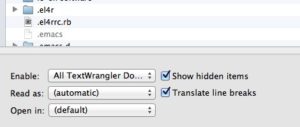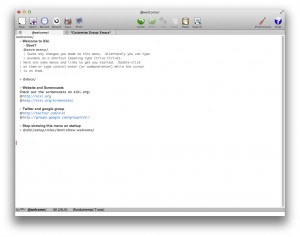You can relieve any sense of panic you may experience while learning Vim by entering the command…
:help!
Passing clouds of inconsequential observations
You can relieve any sense of panic you may experience while learning Vim by entering the command…
:help!
Who does not love exploring the musical warp and weft of minimalist music? I know I do and Steve Reich is a particular favourite.
In the good old analogue days I would make a large (room size) loop of magnetic tape and run that through half a dozen assorted old tape recorders arranged around my room – with some intricate Meccano constructions to keep the tape taught and moving. With some recorders set to play the sound and others to record the sounds played a sound recorded as the tape passed through one recorder would be replayed when that portion of tape reached the next tape recorder and re-recorded on other tape recorders. Thus building interesting delays and overlaps of sounds.
Reich’s experiments revealed that two loops containing the same sounds could be started playing together but one, from slight mechanical variation, would slowly fall behind the other thus creating interesting shifts in the combined sound. He used this technique for both constructed tape pieces and composed pieces such as Clapping Music…
As we moved from the analogue world to a digital world one no longer had to mess about with bits of tape. Reich once observed that where he would spend a month splicing bits off tape together to construct a piece you could now do the same thing on your laptop over a couple of evenings – while watching TV.
One of the best tools for such sonic experimentation is Reaktor which has a an extensive library of User created instruments – several of which are inspired by Reich’s work such as..
Reich Tape Looper:
and It’s Gonna Grain (a play on Reich’s It’s Gonna Rain) and Reichatron which I used for Purple Shift – using two identical loops with one slowly drifting out of sync until it completes its orbit and ends up back where it started
https://soundcloud.com/duncan-moran/purple-shift
Reich’s Music for 18 Musicians is one of the greatest pieces of music ever composed:
But of course the repeating patterns of minimalism is not everyone’s idea of good music and the maximalist Frank Zappa found it ripe for parody with Spontaneous Minimalist Music Composition…
Audio PlayerWho does not love messing about building software synthesisers? I know I do and a basic component for these are oscillators.
Oscillators are used in all manner of things but it is the wobbly wobbly oscillations that can be used to produce a sound that are of most interest. Such things have been around since the late 1800s but today one can recreate their functions with computer software. Here is a simple example I made using the excellent Audulus app.
Who does not love the confluence of coding and music? I know I do and live coding adds a performance element to the process.
Live coding involves writing code that is producing music from scratch and editing and changing the code as the music develops.
As can be seen here once values are changed the revised code is passed to the computer for processing (when it flashes pink) and the revised music is played…
There are an increasing number of languages available for live coding. The above example is Sonic Pi which is probably the easiest to start with as it comes as a ready to go app and does not require any faffing around in the Terminal etc. Others include ChucK, Alda, Extempore which grew out of impromptu (Mac only) etc. There is some debate as to whether graphical languages count as coding but I say they do so that is the end of that debate.
Here is an excellent demonstration of the process by Andrew Sorensen using Extempore…
So that this A to Z thing does not become a catalogue of old records L is definitely not for the greatest record ever made…
Audio PlayerWho does not love mangling some noise with some new Audio Units? I know I do and my Downloads folder is invariably over flowing with Wiggles, Moniques, Hats and the like.
The latest batch included Izotope’s Mobius Filter, PSP’s StompDelay and WavesFactory’s Phi.
The first adds a flanging, phasing, equalisation type effect within a simple and effective interface.
The second provides a plethora of settings for delays, echoes, loops and related effects.
The third utilises the universal Golden Ratio (hence the name Phi) and applies that to enhance even the most mundane recordings. There is probably no type of audio that would not be greatly improved with the use of this plugin.
Chuck them all together and you get Don’t Do Meths…
https://soundcloud.com/duncan-moran/dont-do-meths/s-R4Drh
Only one of the three was released on April 1st 2016.
If the Mac’s App Store has been insisting you constantly need to update the Pro Video Formats to version 2.0.1…
Try using the standalone installer which may convince the App Store that you do not need further updates…
One star reviews in the App Stores are a constant source of fascination and the release of OS X 10.10 (Yosemite) has provided rich pickings. Of course it is frustrating when things are not working properly but many reviewers seem to imagine that the problems they experience with their computers are universal and affecting everyone – there would be rioting in the streets if that were the case. Some even seem to suggest that positive reviews are some form of Apple inspired conspiracy…
The reviewers share their homilies so the rest of us can benefit from their wisdom and insights. One common theme is that Yosemite should never be installed on an older computer as it will be unbearably slow…
I write this on a 2007 iMac with a 2GHz Core 2 Duo processor which is the oldest Mac that is able to run Yosemite. It is used and abused on a daily basis. The update to Yosemite was going to be the excuse to clear it out, reformat the drive and have a fresh clean install but I chickened out as it would be too much hassle to set everything up again and so Yosemite was just slapped on top of everything else…
Over 40000 emails (I did not notice the palindromic number when I took the screen shot)…
Over 1000 apps in the Applications folder…
A couple of hundred bits and pieces installed with Homebrew and a menu bar full of stuff half of which I have forgotten what they do…

Not to mention half a dozen terabytes of external storage hanging off the back.
So how does Yosemite run on this aged, under powered, over loaded wreck? Splendidly…
A couple of minutes worth of Activity Monitor monitoring the activity (that is what it does best) recorded with Screen Flow – so they both occupy high ratings but nothing too taxing.
Thankfully some reviewers manage to figure out that their frustrations are fixable…
Whilst others plant their tongue firmly in their cheek…
Step by step set up using Aquamacs editor with the awesome Xiki…
From these instructions.
Ingredients:
A Mac running OS X Mavericks which should have Ruby 1.9.3 as the default version.
Jewellery Box to manage your Ruby versions (RVM) and gems
The Aquamacs editor.
Recipe:
Open the Terminal and install the Xiki gem…
$ gem install xiki
Verify that all is well…
$ xiki
A Xiki directory will have been created in your Home folder so jump into that…
$ cd ~/xiki/
Then run the set up script…
$ bash etc/install/el4r_setup.sh
You will now need an editor that will see an invisible file (the dot at the start of the name hides the file from being listed in a Finder window: .el4r). I use BBEdit but the free version called Text Wrangler will do the job…

Add these lines to the end of the init.rb file in the .el4r folder within the xiki folder within your Home folder…
$LOAD_PATH.unshift “~/xiki/lib”
require ‘xiki’
Xiki.initKeyBindings.keys # Use default key bindings
Themes.use “Default” # Use xiki theme
Fire up Aquamacs and it should drop you straight into Xiki…

Adapted from this Windows tutorial…
It is much the same procedure but as the Mac speaks fluent MIDI there is no need to add anything.
Ingredients:
A Mac
Ableton Live
iPad
Lemur app
Shove template
ClyphX/Push folders
(Requires a RAR Unpacker if you do not have one)
Procedure:
Right click on the Ableton Live icon and select Show Package Contents
Drill down to the MIDI Remote Scripts folder
Rename the Push folder as Original_Push
Unpack the RAR file containing the ClyphX/Push folders and put those folders in the MIDI Remote Scripts folder
If your WiFi network is liable to interference/lag you should create an ad-hoc network. The video below just connects via the regular WiFi network.
In the iPad’s WiFi settings select your ad-hoc network if you created one
Start the Lemur app and load the Shove template from the Lemur editor on the Mac
In the Mac’s MIDI/Audio set up Utility select the Network button
Connect the iPad to the Session
Open Ableton Live and then its Preferences
Select Push and Cyphx as Input Devices and the network session as Input and Output
Shove away…